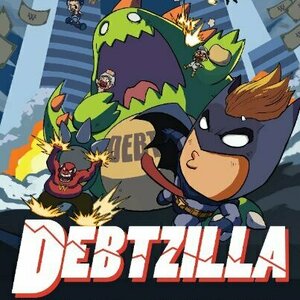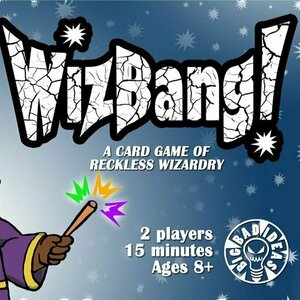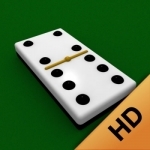
Domino Touch HD
Games
App
A traditional and excellent board game that you can carry anywhere and play anytime! Domino...

Eisenhorn: XENOS
Games and Entertainment
App
POCKET GAMER - 9/10 - "This is a rich and stunning third person adventure" APPLENAPPS - 4/5 -...
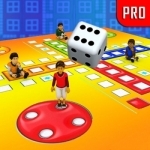
Ludo Adventure Fun 3D
Games and Entertainment
App
(Game Name) has four players red, green, blue and yellow. Are you ready for the royal adventure?...
Purple Phoenix Games (2266 KP) rated WizBang! in Tabletop Games
Aug 3, 2020
A-la-kalhambra! A wizard’s duel has been accepted between you and your rival. Based on the whims of judges wanting displays of specific and ever-changing magic-types, you must cast a flurry of impressive spells to best your opponent. The duel will last exactly 6 rounds and the greatest spellslinger will reign supreme.
DISCLAIMER: We were provided a prototype copy of this game for the purposes of this review. These are preview copy components, and the final components may be different from these shown. Also, it is not my intention to detail every rule in the game. You are invited to download the rulebook, back the game through the Kickstarter campaign launching in August, or purchase through any retailers stocking it after fulfillment. -T
WizBang! is a two-player card dueling game akin to a mashup of War and Crazy 8s. To setup, shuffle the large deck of WizBang! cards, and deal 30 to each player. Similarly, shuffle the small deck of Extra Trick Up My Sleeve cards and deal four to each player. Roll the magic die, place it on the Round 1 section of the round tracking card and the game is ready to begin!
A game of WizBang! is short, sweet, and light on rules. Perfect for that lockdown date night. The game lasts 6 rounds, and each round consists of playing five cards. First things first – roll that magic die. Yellow is Shiny magic, green is Slimy magic, and purple is Weird magic. This means that for the duration of the round, the judges only care about the values that correspond with the rolled magic type. So if Shiny is rolled, each card played (a la War) will compare Shiny values. Highest number wins both cards to the player’s VP stack.
However, Extra Trick Up My Sleeve cards can be played at any time, and can affect either yourself or your opponent. I have included some of those below. These cards do not count for VP at game end, but can certainly shake things up quite a bit during a round. In addition to these special cards, included in the WizBang deck are several Wizard cards that change the preferred magic type for the round or just for one trick. Once all six rounds have been played players count up their VP Spell cards and majority wins! If no majority: SUDDEN DEATH round.
Components. As I mentioned previously, we were provided a prototype copy of the game, but were assured that it is very close to the final version. This game is a bunch of cards and one die. The cards are nice and a little glossy, with sometimes funny art, and even better inside jokes on them. The die is nice quality and easy to interpret which magic source is being judged. All in all the components are good.
I also stated previously that this game is quick. The box says around 10-15 minutes and that’s spot on. I can see seasoned players being able to knock out a game in 5, but for the first few games we were in that 10-15 minute range. What I like about the game is that it is quick. We were needing something to fill a short timeframe, so I broke this one out, taught it to my wife, and played through once or twice before a child needed Mommy. So it definitely fits that bill.
However, the game play itself is a little lacking. Don’t get me wrong – I would play this again, and I would even use it to help teach my son (4 years old) several gaming concepts, but without using the cheat cards. It is basically a combination of War (play a card, winner takes both) and Crazy 8s/UNO (constantly changing trumps) with a wizard duel theme. I love wizards/fantasy themes in my games, so I am still somewhat drawn to this, but ultimately, if I want to play War or Crazy 8s, I might simply break out a normal deck of playing cards to do so.
The game is not at all bad. I really want to stress this. Just for gamers, it is a bit elementary. This would be great in a library’s game collection, or for educational purposes, or even simply as a quick filler game if you want a theme for your War/Crazy 8s hankerin. Need a game for younger gamers? Yes, this. Need a quick game for grandparents or in-law nongamers? This. Don’t know what to play and you’re running out of time (happens to me OFTEN)? This. If you need something like WizBang! in your collection to fill a 2-player fantasy card game hole, definitely check this one out.

Backing Track Builder
Music and Education
App
Create you own custom jam tracks. Pick your chords, tempo and style and let Backing Track Builder do...

Alphabet Preschool Lunchbox Adventure Free - 5 In 1 Game For Kids - Learn Letters, Spelling And Sing ABC Song By ABC Baby
Games and Education
App
###It’s amazing how fast they can learn letters and spelling with this app### ### Warning: This...

Tennis Camera
Sports
App
*** BEFORE BUYING CHECK IF YOUR DEVICE IS SUPPORTED!!! *** Supported Devices: iPhone 5 iPhone...
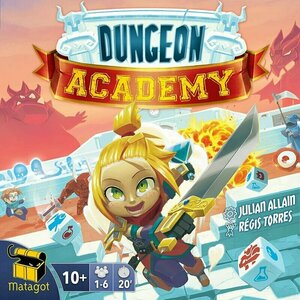
Dungeon Academy
Tabletop Game
Time to enter a dungeon — a dungeon composed of dice! — to kill monsters and score as much as...
